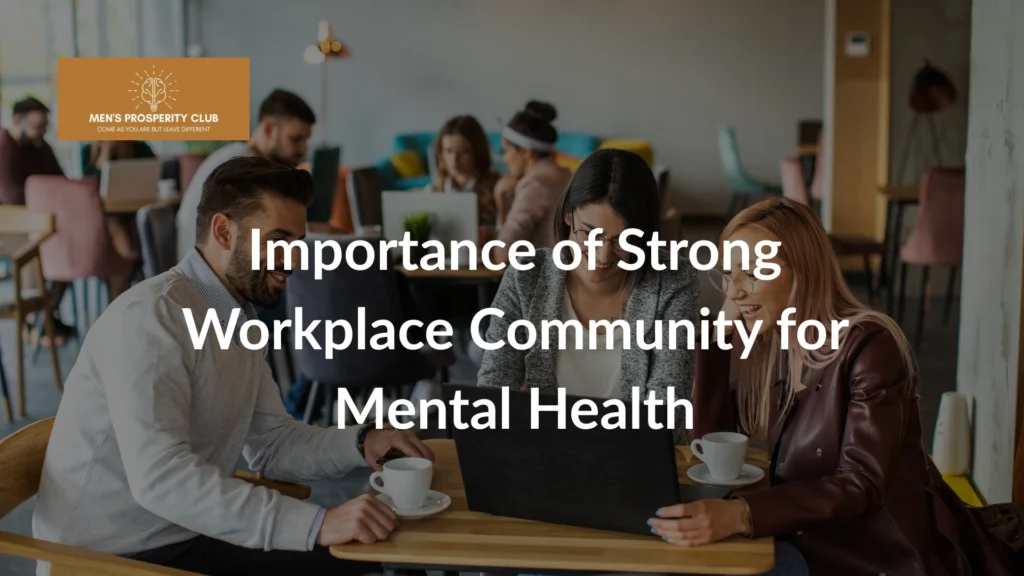This year’s Mental Health Awareness Week (12th to 18th May) highlights how vital community is in supporting mental health. Whether at home or work, a strong community fosters belonging, connection, and resilience. These are key ingredients for maintaining good mental wellbeing.
In the workplace, the value of a community-focused culture is undeniable. Employees who feel included and supported are more likely to engage fully, collaborate effectively, and seek help when needed. For employers, this is a chance to cultivate an environment where people feel safe, respected and connected—not just to their tasks, but to each other. This ultimately leads to greater productivity, higher engagement, and stronger morale.
What is a Workplace Community?
A workplace community is more than just colleagues working together. It is a supportive environment where employees share common values, respect and care. It involves open communication, trust, and collaboration. This community creates a sense of belonging that promotes resilience and emotional safety. When employees feel part of such a community, they are more likely to engage, help each other and seek support when needed.
Why Workplace Community Matters for Mental Health
A strong workplace community positively impacts mental health in several ways. It reduces feelings of isolation and stress while fostering purpose and motivation. People naturally need social connections to feel secure and understood. In a workplace, these connections build emotional safety and encourage openness about mental health challenges. Below are key reasons why the workplace community plays a critical role.
Sense of Belonging
Humans crave belonging. When employees feel accepted and included, their mental wellbeing improves. Being a part of a group at work makes you feel more confident and motivated. The Mental Health Foundation says that being part of a positive community is very important for mental health.

Social Support During Tough Times
Life isn’t always easy, and mental health challenges can arise unexpectedly. A strong workplace community offers social support during such times. This support can be emotional, practical or simply the reassurance of not being alone. Samaritans stress the importance of community support, especially when people face isolation. At work, having peers who listen and understand can be life-changing.
Purpose and Meaning at Work
A workplace community creates a shared sense of purpose. When employees align their values with their work and team, motivation increases. Purpose gives meaning to daily tasks and helps people feel that their contributions matter. This sense of meaning supports mental health by enhancing satisfaction and reducing burnout.
Reducing Isolation and Stigma
Being alone a lot is a big risk factor for mental health issues. Many employees suffer silently due to stigma or fear of judgement. A connected workplace community breaks down these barriers. It encourages open conversations and reduces the stigma around mental health. This leads to earlier help-seeking and more inclusive support for everyone.
Building Resilience and Encouraging Help-Seeking
Strong communities foster resilience. Employees learn to cope better with stress when they feel supported. This support builds emotional strength and reduces burnout. Also, workplace communities encourage employees to seek help when needed. This proactive approach to mental health care benefits both individuals and the organisation.
How Employers Can Build a Supportive Workplace Community
Creating a workplace community that supports mental health requires deliberate effort. Employers play a key role in fostering culture, communication, and connection. Below are practical strategies that employers can implement to build a strong community.
Encourage Open Communication
Open communication is the foundation of any workplace community. Employers should create safe spaces for honest conversations about mental health. This means promoting dialogue among peers and managers. Providing access to resources such as Employee Assistance Programmes (EAPs) supports employees further. Regular check-ins ensure people feel heard and cared for. When employees talk openly, stigma decreases, and trust grows.

Build Employee Resource Groups (ERGs)
Employee Resource Groups connect individuals with shared interests or experiences. ERGs strengthen the workplace community by offering a platform for belonging. These groups can focus on mental health, diversity, or other common themes. ERGs provide peer support and opportunities for meaningful engagement. They foster inclusion and empower employees to voice concerns and ideas.
Provide Social Support Programmes
Social support programmes include mentoring, buddy systems and peer support networks. These initiatives create personal and professional connections among employees. Mentoring helps individuals grow while building trust within the workplace. Buddy systems ease new hires into the community and prevent isolation. Peer support groups encourage sharing and collective problem-solving. Together, these programmes nurture a positive, resilient workplace culture.
Host Wellbeing Events and Initiatives
Wellbeing events and initiatives bring employees together in informal settings. Mental health awareness campaigns, team-building activities and wellness challenges strengthen bonds. These activities reduce stigma and promote shared experiences. Participating in wellness challenges motivates employees to adopt healthier habits. Events also demonstrate the organisation’s commitment to mental wellbeing, building loyalty and morale.

Men’s Prosperity Club: Supporting Mental Wellbeing in Birmingham
In Birmingham, the Men’s Prosperity Club offers a powerful example of how a workplace community can promote mental health. This support group brings together men from various workplaces to share experiences and foster genuine connection.
The club focuses on breaking down the stigma around mental health, especially among men who often hesitate to seek support. Through regular meetups, mentoring and open conversations, members build trust and resilience together.
By providing a safe space for honest dialogue, the Men’s Prosperity Club helps participants feel understood and less isolated. This grassroots initiative has strengthened mental wellbeing for many and serves as a model for how workplace communities can offer practical, emotional support in a meaningful way.
The Benefits of a Strong Workplace Community
Investing in a strong workplace community offers tangible benefits for both employees and employers. Below are some key advantages.
Improved Employee Engagement
When employees feel connected and supported, engagement rises. They become more motivated to contribute and collaborate. Engagement drives innovation, productivity, and job satisfaction.
Higher Productivity and Morale
A positive workplace community creates a happier environment. Happy employees work better and stay loyal. This results in higher productivity and morale across teams.
Reduced Absenteeism and Turnover
Supporting mental health through community reduces stress-related absenteeism. It also lowers turnover rates as employees feel valued and included. Retaining talent saves recruitment costs and preserves institutional knowledge.
Enhanced Reputation as an Employer
Companies known for a supportive community attract top talent. A strong workplace community improves the employer brand. It signals commitment to employee wellbeing and modern, inclusive values.

Steps for Employees to Strengthen Workplace Community
While employers lead culture change, employees also play a vital role. Here are ways employees can contribute.
- Actively participate in community groups and social activities.
- Offer support and listen empathetically to colleagues.
- Encourage open conversations about mental health.
- Share ideas for community-building initiatives.
- Respect diversity and foster inclusion in all interactions.
When everyone takes responsibility, the community grows stronger and mental health improves for all.
Prioritising Workplace Community for Mental Health
Mental health is a critical priority for organisations today. A strong workplace community is a powerful tool to support wellbeing. It creates belonging, reduces isolation, builds resilience, and encourages help-seeking. Employers must invest in culture, communication, and connection. Initiatives like Employee Resource Groups, wellbeing events, and social support programmes make a real difference.
By fostering an inclusive and supportive environment, businesses benefit from higher engagement, productivity, and retention. Ultimately, a thriving workplace community nurtures healthier, happier employees. This is essential for sustainable success in any organisation.




